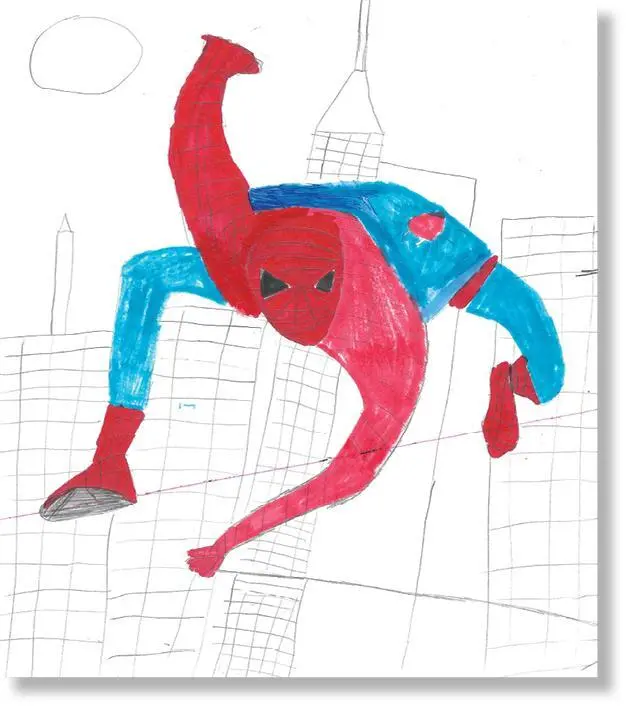1 ...7 8 9 11 12 13 ...18 Importantly, girls in therapy will use drawings as a therapeutic tool to externalize anger and frustrations, but will tend to do it in a supportive environment. In such an environment, they are less preoccupied with how the final product looks.
Another classic study explored gender differences in graphic expression (Hesse 1978). This study found that significantly, boys’ line style and shape design tends to be characterized by dynamism and momentum, while girls prefer clearly defined lines combined with structured static forms. Girls’ subjects are clearer and more understandable, and they are careful to plan their composition and draw a baseline (the ground line), while boys the same age drew a baseline in only half the cases. In terms of coloring, girls tend to use a greater variety, while boys clearly prefer using 1–3 colors out of the entire pack.
Another significant different between the sexes has to do with brain structure (Restak 1982). Girls’ fine motor skills area is larger and better developed than boys’ and this is perhaps why their drawings are considered “nicer”, as well as their handwriting later on. They tend to draw small and carefully rendered figures. This does not mean that boys develop more slowly, but simply that the developmental trajectory used to judge their drawings is different than that of girls. Another difference that may have to do with brain structure is that girls seem to be better in reading facial expressions. This contributes to their developing social skills and also explains their preference to draw human figures and depict the relationships between them.
Indeed, one of the first studies in this area (Goodenough 1926) found significant gender differences in human figure drawings. Boys tend to draw figures in profile with long, dominant limbs, while girls draw small palms and feet. Goodenough attributed these differences to society’s tendency to emphasize girls’ appearance and encourage boys to be more physically active, a tendency that has changed considerably since her studies.
Physiological differences and differential tendencies to have certain disabilities are central to assessing gender differences in drawings. For example, the dominance of their right hemisphere, combined with other physiological factors, mean that learning disabilities are more common among boys. Thus, many cases of refusal to draw or difficulties in drawing and writing are later discovered to be related to dysgraphia or another disability. Particularly in the disabilities area, however, it is very important to avoid jumping into conclusions and test the child’s skills using other diagnostic methods, in addition to drawings.

Figure 1-32:A typically “boyish” drawing
This right hemispheric dominance also means that boys have better spatial perception. They study mazes and love drawing maps and diagrams. They also love drawing vehicles such as airplanes, tanks and cars. The following drawing by a 12½ year-old is a typically “boyish” drawing that emphasizes structure and space, as well as demonstrating considerable effort to reach the required level of accuracy.
To conclude, the objective in interpreting boys’ versus girls’ drawings is not to arrive at generalized conclusions supporting statistical findings about gender differences, but to identify differences that simply mean that the child in question is a typical boy or girl. Children of both genders have always experimented with gender atypical behaviors, a phenomenon that seems to be more acceptable nowadays. When interpreting children’s drawings, you must be keenly aware of such social developments.
Copying
A group of children is seated around the table and everyone is busy drawing. A pair of inquisitive eyes checks neighboring drawings and sees that one girl drew a sun, while one boy drew a red car. The eyes return to their own page and want to draw like that as well. When our children return from kindergarten with a stack of drawings held in their little hands, how can we know which are really their own? Did somebody help them out? Did they copy from others?
Copying is prevalent since early age. Learning by observation is the basic way of acquiring language, for example, and indeed adults also tend to imitate others’ speak, clothing, style and even opinions and ideologies. Given these universal truths, you need to ask, what made the child copy? Is the final product exactly identical to the source or has it been adjusted in some way? Finally, did copying help the child improve his drawing skills and enable him to continue on his own, at a higher level?
Copying has many positive aspects. First, it means the child is aware of his environment. He is curious to learn from older and more experienced children – by studying their behavior he reaches conclusions that are relevant to his future behavior. Second, copying introduces the child to peer society – now he’s just like all the boys (girls): everyone draws spaceships (mermaids) and now he does as well. Copying is often a way of belonging and advancing socially. Clearly, the very act of observing other children’s behavior, regardless of whether it leads to copying, promotes the child as it exposes him to diverse approaches to the same issue and thus sharpens his social perception.
 Figure 1-33:Original drawing
Figure 1-33:Original drawing
 Figure 1-34:Copy by a second child displaying unimaginative, stereotypical elements
Figure 1-34:Copy by a second child displaying unimaginative, stereotypical elements
There are other reasons for copying and imitating, however. Western culture encourages children to develop quickly and be achievers. Children who lag behind will obviously notice this and may copy out of fear of seeming less intelligent. This trend continues and even intensifies during the school years: the fact that all classmates study together and receive grades for the same assignments encourages many children to constantly compare themselves to others, and even copy from them. Observing a variety of drawings by the same child enables experts to identify atypical, “fake” elements. For example, you would find figures or styles that are age appropriate, but rendered in a rigid and stereotypical manner, with no personal touch. By the way, the pressure to perform does not always originate at kindergarten. It is often the parents who insist on teaching the preschooler math and English in order to turn him into a genius that pressure the child, or older siblings whose achievements are a source of envy. In such cases as well, when the atmosphere at home is so demanding, children are liable to copy for the wrong reasons. Remember always that even when children copy from others, their natural human tendency is to leave their own mark, so that the copying child changes the drawing and eventually produces a unique work of art.
7 tips on how to respond to children’s drawing:
•Look at his drawing when you are available for it
•State clearly what you can see in the drawing
•Ask him if he wants to explain his drawing and respect his answer
•Try not to give him remarks on “mistakes” in his drawing
•Avoid overwhelming him with questions so as not to pressure him
•When you give compliments, do it fairly and meaningfully
•Encourage his creativity rather than the final outcome
Читать дальше


 Figure 1-33:Original drawing
Figure 1-33:Original drawing Figure 1-34:Copy by a second child displaying unimaginative, stereotypical elements
Figure 1-34:Copy by a second child displaying unimaginative, stereotypical elements










